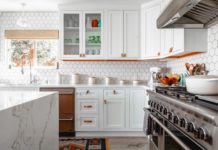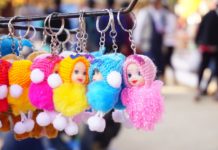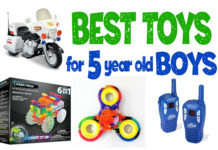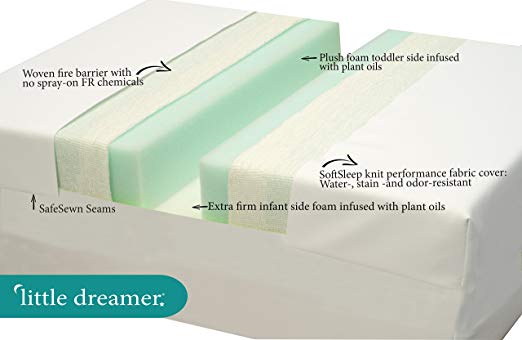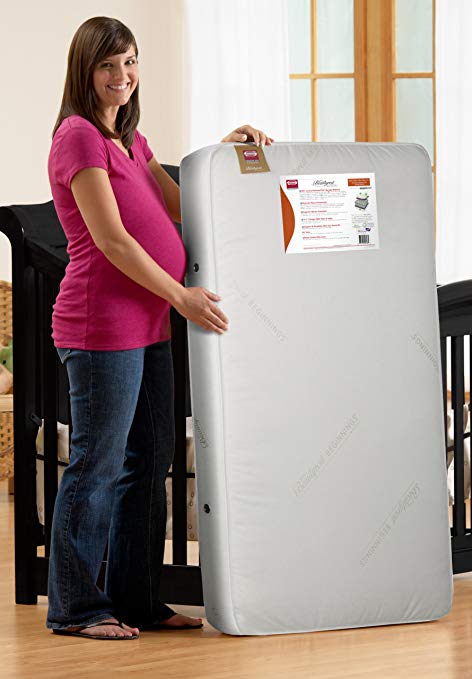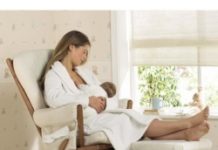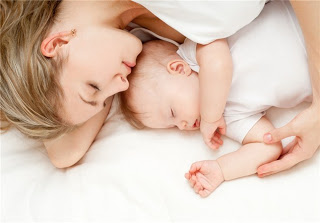Figuring out what baby mattress would suit your little one isn’t easy. There are a lot of things to consider, especially since your baby is going to be spending time on that mattress for a good 16 hours a day. Safety and comfort may be key, but there are other things you’ll need to factor in such as shape, weight, breath-ability, material, etc. If you’re not sure where to start, we’ve compiled this list of the best baby mattresses that should fit most parents’ and babies’ needs. If you’re considering buying a mattress for an adult, be sure check the best mattresses on handsonmattress.com for valuable advice
#1: Newton Wovenaire Crib Mattress

The Newton Wovenaire is a one-of-a-kind mattress. It is comprised of Wovenair material which is a block of food-grade polymer, 90% of which is just air. Yes, you read that right. And because of this revolutionary material, the mattress is “breathable” with air flowing freely through the mattress. In fact, it has been tested by an independent CPSC accredited lab and proven to reduce the risk of suffocation and CO2 rebreathing. The 3-dimensional spacer fabric used to create the cover is also highly breathable. Because there is no foam, springs, latex, or other commonly used materials in making this mattress, it has no off-gassing, toxic chemicals, or allergens at all. It’s even GREENGUARD Gold certified to prove it. And there’s more. The cover is machine-washable and the entire bed can be washed in a shower or tub. Plus, your baby can still continue using the bed until he’s no longer a toddler. Yes, it is firm enough for a newborn and yet cushy enough that a toddler can sleep comfortably on it. How about that, eh? The only drawback is the price. It’s very expensive. Oh, and one more thing, the cover isn’t as soft as we’d like and using a cover isn’t recommended for the first few months to ensure that air is allowed to escape from the mattress and keep your baby cool.
- Revolutionary Wovenaire material
- 100% washable
- very comfortable
- expensive
- cover isn’t that soft
#2: Colgate Eco Classica III Crib Mattress

No, this isn’t the same Colgate that makes your toothpaste. But this one does make exceptionally good baby mattresses. The Eco Classica III Dual Firmness crib mattress features a certified organic cotton cover, a natural cotton flammability barrier, a firm eco foam infused with plant oils on the infant side, and a less firm eco foam for toddlers on the other side. Have we mentioned that the foam is CertiPUR certified? The mattress is hypoallergenic and phthalate free. It is GREENGUARD GOLD certified. The firmness of the infant side (and even the toddler one) is sufficient for any infant. Even the edge support barely showed a dent when pressed down on. It’s lightweight and fits perfectly in US standard cribs. There was no off-gassing and the mattress seems cool and soft. However, it isn’t completely organic; only the cover is. And it’s still pretty expensive at almost $200.
- GREENGUARD GOLD certified
- CertiPUR certified foam
- dual firmness
- not organic
- slightly pricey
#3: Moonlight Slumber Little Dreamer Crib Mattress
The Moonlight Slumber Little Dreamer is another eco-friendly option for parents. While it isn’t 100% organic, it does have the two necessary certifications that can ease any parent’s mind – CertiPUR-US certified and GREENGUARD Gold certified. The mattress has no off-gassing or toxic chemicals and features a medical quality fire barrier as well as a water-stain and odor-resistant fabric. The foam is plant-based and free of polyethylene, PVC, phthalates, and lead. Even the waterproof material is safe for your baby. The cover is made of nylon fabric which we’ve mentioned is waterproof, odor-resistant, and water stain resistant. But what we haven’t mentioned is how silky it feels. Who needs a crib sheet with this kind of cover? Since this is a dual-firmness mattress, you’ll find that one side is slightly firmer than the other though some parents feel that the toddler side is still too firm to be comfortable. Also, this is as expensive as our other pick, the Colgate Eco Classica III.
- waterproof
- eco-friendly materials
- very lightweight
- not completely organic
- expensive
- some find the firmness too hard
#4: Sealy Soybean Foam-Core

For parents who have a limited budget but still want something eco-friendly for their baby mattress, the Sealy Soybean Foam-Core crib mattress may just be what they’re looking for. This Greenguard Gold certified, CertiPUR-US certified mattress features a waterproof, reinforced pearl-embossed cover to make for easy clean-up. The hypoallergenic cotton wrap surrounding the foam adds comfort to the firmness provided by the foam core. All the materials used in the mattress has been independently tested to be free of antimony, formaldehyde, mercury, BPA, and other chemicals found on the CHCC (Chemicals of High Concern to Children) list. It has square corners to ensure a snug fit inside USA standard full-size cribs. The mattress is very firm using a 1.5 pound density foam. Overall, it’s a decent eco-friendly choice especially at this price point. However, the cover’s design is “raised” a bit which you can feel if you sleep on this without a cover. Picky babies and toddlers may mind feeling that design on their cheeks. Also, the waterproof cover is vinyl-laminate which has been tested to have no phthalates and low emissions. But something any parent should take note of. Also, some parents have reported the cover cracking or splitting after a year or two. Since this is supposed to serve toddlers as well, it certainly should last longer than that.
- GREENGUARD GOLD certified
- CertiPUR certified foam
- dual firmness
- not organic
- slightly pricey
#5: Safety 1st Heavenly Dreams
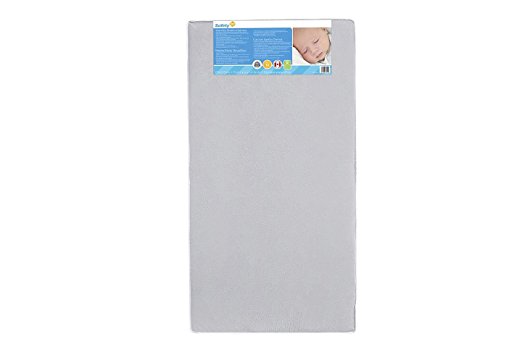
The Safety 1st Heavenly Dreams mattress is definitely the budget-friendly choice at less than $100. But that doesn’t mean you have to settle for less quality. This mattress is comprised of high-density thermo-bonded fiber core made from polyester that is wrapped in a vinyl covering to make the mattress waterproof as well as resistant to stains and smells. You can remove the cover to wash it if required. The mattress is GreenGuard Gold certified so you know that it meets the standard for low-chemical emissions. The cover is also free of phthalates and lead. The mattress is very firm, just what your baby needs, and fits snugly inside a standard crib. However, the vinyl cover won’t last more than 2 years as some parents have reported. Sagging has also been reported around that time. And while we didn’t notice it ourselves, some parents reported a slight smell after unpacking that did go away after a day.
- GreenGuard Gold certified
- easy to clean
- very affordable
- sagging and tearing after 2 years
- some reports of slight smell after unpacking
- vinyl cover
#6: “My First Mattress” Memory Foam Mattress

The “My First Mattress” is made from memory foam which doesn’t exactly sound like a safe option for babies. Isn’t that going to sink? Well, this CertiPUR-US certified memory foam doesn’t and we’ve checked to make sure. It is high-density memory foam that will be supportive and safe. Aside from being firm enough for your little one, this mattress is also hypoallergenic, phthalate and lead free, mite-proof, and anti-microbial. The velour cover feels plush and soft. More importantly, it is removable and machine-washable. And have we mentioned that it’s waterproof? However, there is a slight smell after unpacking the mattress. It does go away if you let it breathe for a day or two. Also, it takes a few days for the foam to expand to full size after being packed so tightly, so you need to purchase this at least a week or so ahead of when you need it. One unfortunate thing to keep in mind is that some parents have reported that the waterproof cover isn’t so waterproof after all. While it didn’t happen with us, you might get a lemon so you’re forewarned.
- soft, plush cover
- CertiPUR-US certified high density memory foam
- less pricey
- slight smell after unpacking
- requires days to fully expand
- some parents received a cover that was not waterproof
#7: Simmons Beautyrest Beginnings Sleepy Whispers
The Beautyrest Beginnings Sleepy Whispers mattress is a dual firmness innerspring mattress that features 231 luxury pocketed coil springs, reinforced border protection, and Innofoam corner protectors to provide your child with a firm, flat sleeping surface that’s stable and comfortable. The mattress is Greenguard Gold and CertiPUR-US certified. It features a hypoallergenic, water resistant superior woven cover as well as a 100% natural cotton fire protection wrap. It comes with a limited lifetime warranty. However, this thing weighs a hefty 20 pounds which can make changing covers literally painful, especially if you need to do it a lot. Also, while the bounce isn’t considerable here, this could still be a problem for toddlers who learn to use their bed as a trampoline.
- dual-firmness
- Greenguard Gold and CertiPUR-US certified
- 231 luxury pocketed coil springs
- very heavy
- not for toddlers who like jumping on the bed
#8: Milliard Hypoallergenic Crib Mattress
The Millard Hypoallergenic Crib Mattress is made with a CertiPUR-US certified foam with a density of 28D that will provide your baby with the safety and support he or she needs as he/she sleeps. The hypoallergenic waterproof cover ensures that clean ups are easy; it is non porous which protects the mattress against mold, mildew, dust mites, bacteria, and other allergens. However, this waterproof cover doesn’t last long and feels stiff. You might want to just use your own. The mattress itself is great and fits snugly in a standard crib. For less than $60, this baby mattress is definitely a good deal.
- CertiPUR-US certified foam
- very affordable
- good quality
- waterproof cover doesn’t last long
- cover is stiff
#9: Emily Crib Mattress
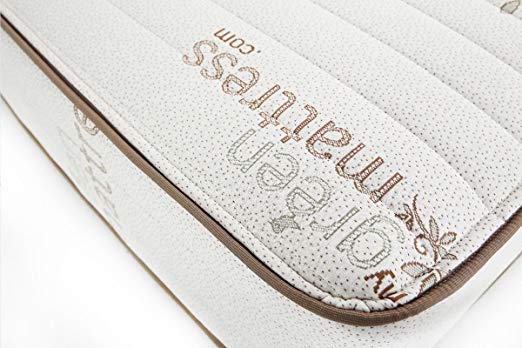
If you’re wary of any kind of foam in your baby mattress, the Emily Crib Mattress should just be right up your alley. This innerspring mattress features heavy duty 150 coil springs, GOTS certified organic cotton batting, and a natural Eco-wool quilted cover. Did you know that wool is flame resistant? It’s also resistant to mold, mites, and mildew. But the best thing about wool is that it is both cool and warm. In the summer, it will wick away moisture so you stay cool. In winter, it is insulating so you stay warm. Let’s just say this mattress has got your baby covered year-round. The entire mattress is GREENGUARD Gold Certified, non-toxic, and comes with a 10-year warranty. This is a double-sided mattress which means you can easily flip it over if your baby has an accident on one side. However, all these good things about the mattress comes with a price – a hefty one at that. Also, you may need to air the mattress out for a few weeks. It’s all natural and who said sheep don’t smell? It will air out eventually as many parents can attest to.
- 100% organic
- GREENGUARD Gold Certified
- double-sided mattress
- very expensive
- may smell really bad initially
#10: Sealy Nature Couture Cotton Bliss 2 Stage Infant-Toddler Crib Mattress
The Sealy Nature Couture Cotton Bliss 2 Stage Infant-Toddler Crib Mattress is another dual-firmness bed that provides a safe sleeping surface for both infants and toddlers. This innerspring mattress features 204 heavy gauge steel coils plus six Everedge pylons to provide excellent edge support on all sides and corners of the mattress. The infant side (which is identified by a silk name tag) features firmer layers with an anti-sag interior steel system to make sure that it remains firm and flat. The toddler side, on the other hand, features layers of certified organic cotton cushioning to create a plusher feel. The entire mattress is covered by an organic cotton and polyester wrap which is free of plastics like PVC, vinyl, and polyethylene but still waterproof. Small metal vents on the sides of the bed ensures airflow. However, there have been reports of sagging and torn seams.
- dual-firmness mattress
- certified organic cotton cushioning
- affordable
- reports of sagging and torn seams
- not entirely organic
Baby Mattress Buying Guide:
Your baby’s bed is one of the most important purchases you’ll ever make as a new parent. He or she will be spending around 70% of his time on that bed so it’s vital that you get a good one. More importantly, the right mattress should give your little one the support his developing body needs while reducing the risk of SIDS (Sudden Infant Death Syndrome). According to the National Institute of Child Health & Human Development, your baby needs a safe sleep surface, a mattress that’s firm, flat, and fits in a safety-approved crib. This definitely rules out your own bed or even a toddler bed. But how do you know which baby mattress is firm enough? And is that the only important consideration to make? Choosing your own bed was hard enough. Which is why we’ve constructed this guide to help ease the burden and anxiety when it comes to purchasing something so essential to your baby’s safety and health.
What is a baby mattress?
Also called a crib mattress, a baby mattress is one that fits the following specifications according to federal law:
- at least 27.25″ wide
- 51.625″ long
- not more than 6″ thick
A lot of crib mattresses are sized quite near these parameters – approximately 27.5 inches wide, 52 inches long, and 5 to 6 inches thick which enables them to fit in most cribs.
What is the exact size that you need?
As we’ve mentioned, most crib mattresses are roughly the same size due to the federal mandate. However, some cribs have a unique shape (i.e. oval) which will require a similarly shaped crib mattress. And while most cribs will likely accept any standard sized mattress you buy, there will be small size variations which could lead to gaps between the size of the mattress and the frame of the crib. As small as the gaps may be, it can still be a source of suffocation and entrapment. Definitely not the way to give your baby (and you) sweet dreams. Before you buy the baby mattress, make sure that it will be a snug fit when placed inside the crib.
What type of mattress are you looking for?
Baby mattresses come in two main types based on the material used – foam or innerspring. A new category that has grown more popular over the years is the organic mattress. Now, there are pros and cons in each one (we’ll talk about them more later) but keep in mind that there is no “best” type. All categories will have great quality mattresses and not-so-great ones. You need to make sure that whichever type you choose, it meets the quality and safety standards set by the government.
Foam
Foam baby mattresses are more popular generally because they’re cheaper. And we all know how expensive baby items can get. But less expensive doesn’t mean less quality. This type of mattress is also generally lighter (7 to 8 pounds) which is a plus when you’re cleaning the bed, changing the sheets, etc. However, foam is squishy so you need to make sure that the foam is firm. If it conforms to your baby’s shape, it may increase the risk of suffocation and SIDS occurring. It also won’t provide adequate edge support which may result in your child getting trapped at the edge if he rolls into it. You want something that will remain firm even when you press your hand on the foam. Don’t be too worried about the bed being too firm for your baby. Remember, this will be your baby’s bed for at least 9 months. Safety is paramount. Also, he or she will be using it to learn how to roll and kneel. Lack of firmness will disrupt his or her developmental milestones.
If you prefer a foam mattress, look for one that has high density. Don’t rely on what the manufacturer states on the product information. It’s important that you perform a squeeze test on the mattress. Press down on the center and edges of the bed to see if it springs back readily or conforms to the shape of your hand. You can also squeeze the bed from each side using your hands and see how far it will let you “push” it. A dense mattress won’t let you get very far. Aside from safety and developmental milestones, high density will also ensure longevity. The Colgate Eco Classica III Crib Mattress is one of the firmest foam mattresses we’ve tested. And yes, it should really be that firm.
Innerspring
Innerspring baby mattresses are typically more expensive and heavier (around 15 to 25 pounds). This is due to the coil springs used inside the mattress. Generally, the more springs there are, the firmer a mattress is. This type of mattress also usually features border wiring to keep the edges sturdy which means the bed usually has great edge support.
As we’ve mentioned, the number of coils inside can affect the firmness of the bed. But the thickness of the gauge steel used to make the coil springs can also affect firmness. Even if a mattress has 250 coils but they’re made of thinner steel, they probably won’t provide a level of firmness much different from a mattress with 150 coils but with a lower gauge (thicker steel). If you prefer an innerspring mattress for your baby, look for one that has around 135 or more coils with a gauge of 15.5 or lower. The Simmons Beautyrest Beginnings Sleepy Whispers has 231 pocketed coil springs.
What about organic mattresses?
We’ve all been trained by marketing professionals to think that everything labeled as organic is healthy and safe. What we have yet to realize is that “organic” doesn’t mean 100% organic – a loophole that manufacturers have used to claim their product is organic. So, how do you classify a baby mattress as organic?
No Polyurethane Foam
Most mattresses use polyurethane foam which is actually made from petroleum, something that we all know as potentially toxic. But to create the foam, manufacturers may use a number of harmful chemicals such as formaldehyde, benzene, and toluene.
Now, before you go think that all foam mattresses are bad, you should know about the CertiPUR-US certified label. All polyurethane foams with this label like the Moonlight Slumber Little Dreamer Crib Mattress has been independently tested and confirmed to have been made without ozone depleters; PBDEs, TDCPP, or TCEP flame retardants; mercury, lead, and other heavy metals; formaldehyde; and phthalates. In addition, that label also indicates low VOC (Volatile Organic Compound) emissions for indoor air quality.
No PVC’s with Phthalates
Most baby mattresses feature a vinyl covering because we all know how messy a baby can be. However, what few realize is how toxic and damaging this waterproof covering is to the environment. Chemical plasticizers are used to make this material softer and more flexible. These are then are breathed in by our kids and absorbed by their skin which can lead to several negative health effects such as asthma, cancer, and kidney and liver damage.
PBDEs
Polybrominated diphenyl ethers are flame retardants that have been used for decades to make all mattresses, including crib mattresses, flame-resistant. A lot of organic mattresses use wool instead because it has natural fire-retardant properties. However, they may still use chemicals to increase its flame-resistant properties. You’ll have to make sure that you do your due diligence – research the heck out of the manufacturer’s complete material listing.
So, what is an organic mattress made of?
This type of mattress should consist of all-natural materials such as wool, cotton, coconut fibers, food-grade polymers, natural latex, and/or plant-based foam. True organic mattresses will have the CertiPUR-US label (if it contains foam) as well as a Greenguard Certification. This certification is another form of assurance to an anxious parent that the mattress has low emissions of VOC’s. While organic mattresses are typically expensive, a lot of parents believe that the peace of mind they gain from using them is well worth the price. While the toxicity of the chemicals we discussed above is still being researched and analyzed by specialists, it may be better to be safe than sorry. The Sealy Soybean Foam-Core, like most of our picks, has a Greenguard Gold certification though it is not completely organic. The Emily Crib Mattress, on the other hand, is completely organic featuring GOTS certified organic cotton batting and a natural Eco-wool quilted cover
Any other factors I should consider when making my purchase?
We’ve talked about size, density, and firmness. We’ve even touched a little on weight which will mainly be a personal preference. But there are other considerations for you to think about.
Mattress cover: there’s no way for you to avoid your baby making a mess. A blowout is inevitable and it’s never going to be fun to clean. But to keep your mattress from staining (and making your life just a tiny bit easier), you may want to look at a mattress cover or ticking. Double or triple-laminated ticking with nylon like what is used with the Moonlight Slumber Little Dreamer Crib Mattress is best since this is not only resistant to soggy diapers but to tears and holes as well. If you’re going organic, you’re going to have to look for a waterproof mattress cover that fits snugly over your baby’s bed.
Breathability: yes, you’re going to want a “breathable” mattress because it will ensure your baby sleeps cool. If it gets too hot, they can sweat and overheat which is a factor that could increase the risk of SIDS. Also, look for vents at the side of your baby mattress. This also allows the bed to “breathe” which ensures that the material within won’t be absorbing the unpleasant smells that your baby produces. The Newton Wovenaire Crib Mattress is the most “breathable” mattress in the market today.
2-stage or Dual Firmness: your baby isn’t always going to need that very firm mattress. At around 12 months, once he or she is now mobile, comfort will become a factor. With a dual firmness baby mattress, you’ll get one side that’s extra firm and the other that would have an extra foam cushion to provide some added comfort. When your baby is able to roll, sit, and stand on his own (or with the help of the crib bars at least), then you can flip the mattress over to provide added comfort to his sleep. The Simmons Beautyrest Beginnings Sleepy Whispers is one of several beds on our list that has dual firmness.
Take note that whatever baby mattress you end up choosing, you should make sure you follow the American Academy of Pediatrics’ safe-sleep guidelines.
